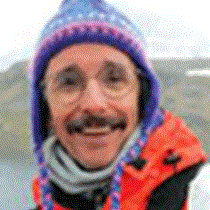New Island & Carcass Island, Falklands
In 1833 when 24-year-old Charles Darwin visited the Falkland Islands, he was not impressed. The low geography, unrelenting rain and wind, and a bad case of homesickness rendered the young naturalist unreceptive to the sweet subtleties of this rocky archipelago. Not so 171 years later when the Endeavour dropped anchor at New Island amid sunny skies and a light breeze.
There to greet us on a white sand beach were kelp geese and upland geese, a black-crowned night heron nesting in a wooden hulk (wrecked in 1968), singing thrushes and meadowlarks, yellow-flowering gorse, and the island’s two owners, Tony Chater and Ian Strange, both artists, authors and conservationists. We walked a kilometer up a slight incline into the wind, to the other side of the island where black-browed albatrosses, rockhopper penguins and imperial shags nested in tight quarters. What constant chatter and ecstatic greetings. What good fortune to watch great winged sailors riding waves of wind, feathers unfurled, so many birds hovering and dancing with the sky: albatrosses, shags, dolphin gulls, brown skuas, straited caracaras (aka johnny rooks) and the occasional turkey vulture with its great dihedral wings. Many birds sat on newly-laid eggs while others went about the business of home improvement (adding to their pedestal nests), greeting one another, and courting for the new season.
During lunch we traveled some 40 nautical miles to Carcass Island, owned by Rob and Lorraine McGill. Again, a rich tapestry of wildlife, so much color and song, followed this time by British tea and a table filled with cakes in the McGill kitchen. Darwin never had it so good. Amber light poured over the gorse and rocky shore as the sun settled low. Some of us hiked to the far end of the island while others sat near the settlement to let the birds come to us: Magellanic penguins, black-crowned night herons, striated caracaras (one caracara taking a dust bath on the dry footpath) tussock birds, Magellanic and blackish oyster catchers... including one oystercatcher nesting at the head of the jetty, its bright eye on us as we passed by only a couple meters away. Such tolerance. A great day.
As ornithologist Robert Cushman Murphy wrote, “Now I belong to a higher cult of mortals, for I have seen the albatross.”
In 1833 when 24-year-old Charles Darwin visited the Falkland Islands, he was not impressed. The low geography, unrelenting rain and wind, and a bad case of homesickness rendered the young naturalist unreceptive to the sweet subtleties of this rocky archipelago. Not so 171 years later when the Endeavour dropped anchor at New Island amid sunny skies and a light breeze.
There to greet us on a white sand beach were kelp geese and upland geese, a black-crowned night heron nesting in a wooden hulk (wrecked in 1968), singing thrushes and meadowlarks, yellow-flowering gorse, and the island’s two owners, Tony Chater and Ian Strange, both artists, authors and conservationists. We walked a kilometer up a slight incline into the wind, to the other side of the island where black-browed albatrosses, rockhopper penguins and imperial shags nested in tight quarters. What constant chatter and ecstatic greetings. What good fortune to watch great winged sailors riding waves of wind, feathers unfurled, so many birds hovering and dancing with the sky: albatrosses, shags, dolphin gulls, brown skuas, straited caracaras (aka johnny rooks) and the occasional turkey vulture with its great dihedral wings. Many birds sat on newly-laid eggs while others went about the business of home improvement (adding to their pedestal nests), greeting one another, and courting for the new season.
During lunch we traveled some 40 nautical miles to Carcass Island, owned by Rob and Lorraine McGill. Again, a rich tapestry of wildlife, so much color and song, followed this time by British tea and a table filled with cakes in the McGill kitchen. Darwin never had it so good. Amber light poured over the gorse and rocky shore as the sun settled low. Some of us hiked to the far end of the island while others sat near the settlement to let the birds come to us: Magellanic penguins, black-crowned night herons, striated caracaras (one caracara taking a dust bath on the dry footpath) tussock birds, Magellanic and blackish oyster catchers... including one oystercatcher nesting at the head of the jetty, its bright eye on us as we passed by only a couple meters away. Such tolerance. A great day.
As ornithologist Robert Cushman Murphy wrote, “Now I belong to a higher cult of mortals, for I have seen the albatross.”




